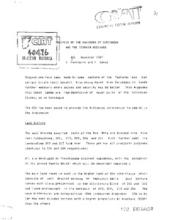/ library resources
Showing items 1 through 9 of 29.In Thailand cassava is produced mainly for export. The Thai cassava industry was based on starch export until the 60s when West Germany began to use CSW for animal feed. As this was a by-product of starch manufacturing, shortages resulted, leading to the market for CM.
This analysis of global and Asian markets looks at protectionism and substitution (decline in starch trade, rise in trade of cassava feedstuffs) and the Asian regional market for cassava feedstuffs.
Presents papers on inventory of animal feed resources in Kenya, Tanzania, Ethiopia, Zimbabwe, Malawi, Burundi, Madagascar, Botswana, Swaziland and Mozambique, research and development experiences in Kenya, Tanzania, Burundi and Zimbabwe; socioeconomic aspects of feed resources; and regional/sub-r
Presents a theoritical outline of the techniques in the use of tritiated water (HTO) which can be used to estimate total body water, body composition, water turnover, milk intake and feed intake.
Presents results of studies on the utilization of agricultural by-products as livestock feeds in Africa.
Discusses the use of forage legumes in the contexts of seasonality of other feeds particularly natural pastures and crop residues, the seasonality in animal movements, the competitiveness for land and labour of forage legumes, and the complementarity of forage legumes with other feeds in smallhol
Reviews the appropriateness of three major assumptions underlying pastoral development in East Africa, viz, economic irrationality of pastoralists, the unchanged nature of pastoral production systems, and the applicability of western models to pastoral development.
Paginação
Land Library Search
Through our robust search engine, you can search for any item of the over 73,000 highly curated resources in the Land Library.
If you would like to find an overview of what is possible, feel free to peruse the Search Guide.







